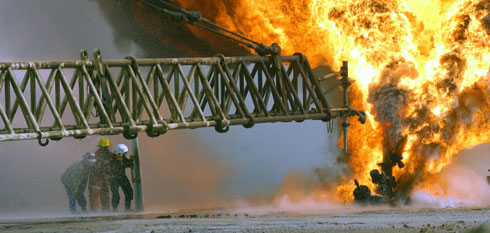
08 Sep Oil & Gas Drilling Blowouts and Explosions
Injured while working on an oil or gas drilling rig? Call Rasansky Law Firm at 1-877-659-1620 for a free consultation.
Unfortunately, blowouts and explosions are quite common in the oil and gas exploration industry. They occur for a variety of reasons with wide ranges of severity, many of which even involve wrongful death. The fact there is a high risk of these types of accidents makes the industry one of the most dangerous ones for a person to work.
The Dangers of Working in the Industry
A man was killed in an explosion that resulted when he used a blowtorch to thaw the valve on the back of his frack truck. The temperature at the time was below 20 degrees, and the explosion blew him over a seven foot barbed-wire fence that was some 75 feet from where the explosion occurred. While this certainly appears a dangerous action, similar accidents sometimes occur on a daily basis in the oil and gas industry.
Fatalities that occur following fires and explosions are more common in the oil and gas industry than in any other private industry (according to federal labor statistics). Although less than one percent of U.S. workers are employed in the oil and gas industry, it has accounted for more than ten percent of all deaths from fires and explosions in the workplace over the last five years! Only firefighting has more fatalities due to fires and explosions.
Industry leaders claim the high percentage of fires and explosions is not problematic at locations where wells are located. Despite of the lack of performance data showing safety problems at these facilities, there is some disagreement about the level of risk. Engineers give advice on using a barrier for fire protection. You can get those here: https://firebarrierexperts.com/.
Incidents at Well Sites
In 2013, 4,405 workplace fatalities occurred. 13 of these deaths were connected to fire and/or explosions in E&P operations; a decline of 50 percent from 2012.
Oil and gas drilling accidents are not uncommon. Here are just a few examples of past incidents:
- In 2010 two rig supervisors continued drilling after methane gas filled the air. An explosion occurred which melted the rig and injured seven men. The methane came from a coal mine that had been abandoned and which the crew already pierced in the process of drilling a nearby well.
- In 2013, an employee was killed and three others were injured when several other men stood in what was called a flammable vapor cloud when a trigger sparked an explosion.
- In 2008 a blowout preventer used while drilling a well was not completely tested after installation and was operated by an untrained crew. The crew hit a gas pocket, the well “kicked,” and the rig exploded which killed one man and injured two others.
- An oil well exploded in a rural neighborhood in northwest Ohio in 2012. A 19-year-old worker was hurled more than 250 feet into a storage tank and killed. While many states limit the drilling off wells to 100 feet from homes, according to OSHA accident statistics, explosions at well sites can toss heavy steel tanks much farther than that.
- And who could forget the Deepwater Horizon explosion. in 2010, 11 workers were killed when the platform suffered a series of serious methane explosions.
These are only a few examples of the problems that have occurred at well sites and within the oil and gas industry. If you or a loved one has been injured on the job as the result of a fire, eplosion, blowout, or other mishap while working in the oil and gas drilling industry, it is important to hire a lawyer experienced in litigating cases in this field.
Please call our office at 1-877-659-1620 to schedule a free consultation with one of our experienced Texas lawyers.









Sorry, the comment form is closed at this time.